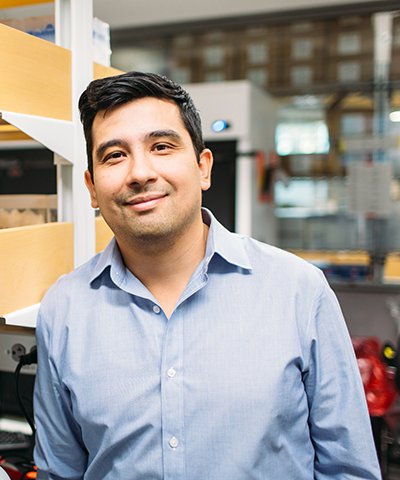
What is the focus of your research?
Ultimately, our research is anchored in the exploration of the genome, seeking to uncover the differences between all of our DNA and what makes us unique as individuals. We are interested in unraveling how stem cells function within our bodies, how they change their behavior as we age, and understanding the underlying factors influencing their actions.
We build technologies that facilitate understanding the genome, comprising 3 billion individual letters, or pieces of information, in each cell. Our approach incorporates engineering and computational tools to create new platforms and analyze the large amounts of unique data obtained from our experiments.
What drew you to this line of research?
My own background is actually in bioengineering — that was my passion — so I have always been at the intersection between hypothesis-driven biology, observational biology, and engineering. I always loved tinkering and building things.
I was an EMT for many years but during my undergraduate studies, I visited a company working on DNA sequencing technologies and was amazed at the interdisciplinary nature of sequencing technologies. Witnessing scientists and engineers from various fields collaborating on new technologies was a transformative experience. From that point on, I was driven to integrate knowledge from different disciplines to tackle hard problems in biology. By building new devices, inventing technologies, and writing computational code to decipher the resulting data, I have found a way to make an impact in biological understanding. I feel very passionately about sharing these tools with others.
How do the technologies you develop differ from those of others in the field?
One of the distinguishing factors of our research is the emphasis on understanding DNA and its immense coding potential. We also seek to address one of the major grand challenges in biology which is understanding how the genome is unique to each cell. So the technologies we build are related to understanding the axis between DNA, the proteins that are being made, and how they are regulated. Most of the tools we have invented are ways of understanding our genomes in single cells. This research has immense relevance in stem cell biology, as it enables us to identify proteins that could be utilized for cell therapies and understand the mechanisms underlying specific diseases.
For the past eight years, our approach has been to study tissue – from the brain, heart, skin, etc. – to tease apart all of the individual cells, and compare genetic codes between different cell types. By categorizing cells based on their genetic information, we can explore how specific genetic variations might explain the occurrence of diseases between individuals.
Tell us more about your collaborative approach to research.
Almost all of our work is collaborative in nature. Collaboration is ingrained in the research culture here, at the Broad Institute where I am a member, and also in the busy, dense research hub of Boston and Cambridge. Most of the things we do have at least one collaborator as we are either borrowing or sharing with other teams.
What aspect of your research are you most excited about?
We are excited that the work we have done understanding how genomes are structured and function within single cells is finally bearing fruit. Commercialization of our technology by companies like Tenex and others has made them more accessible to a broader audience. Even within our own lab, we continue to refine those tools, making them more robust and scalable.
I have been excited to use these tools. I have committed my scientific life to building, both within our lab and with collaborators, for so many purposes like studying cancer biology and aging. In the process, we have learned a lot about how the genome works and how to manipulate proteins in cells to move them back to healthy states. Now, we are really leveraging these tools to find potentially therapeutic opportunities to make these cells function correctly again.
